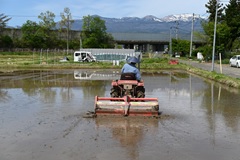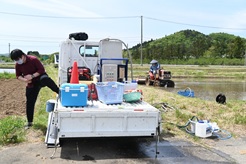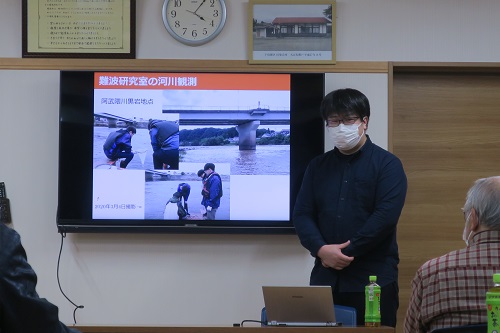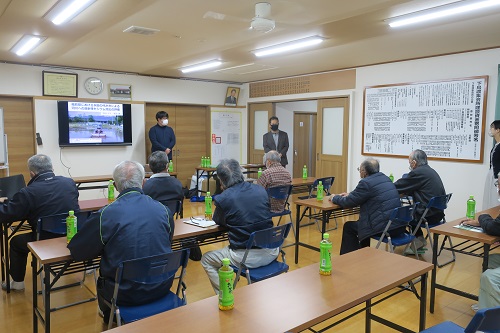November 14, 2020 14th Dialogue meeting was held in Fukushima City
Date & Time
Saturday, November 14, 2020 16:00-17:30
Venue
Shimotoriwata meeting hall (Fukushima City)
Speaker
Shota Moritaka 2nd year of master’s program of Environmental Radioactivity major
Kenji Nanba IER Director / Professor
Title
Estimation of radiocesium wash-off to the river caused by “Shirokaki” (a preparation process of paddy fields before rice planting) in Fukushima Prefecture.


We held the first dialogue meeting of the year at a local meeting hall in Shimotoriwata, Fukushima City, on the theme of “Estimation of radiocesium wash-off to the river caused by “Shirokaki” in Fukushima Prefecture. Eleven local farmers who helped with this research attended the meeting.
Mr. Shota Moritaka studies the dynamics of radiocaesium in Abukuma River in master’s program of environmental radioactivity major. He has observed and analyzed river water of Abukuma River since 2017 in Prof. Nanba’s laboratory, and has continued his research under Prof. Wada at IER for his master’s study. For the dissertation research, he focuses on seasonal fluctuations in dissolved Cs-137 concentrations in the river water, especially its increase in May. He assumed that one of the reasons of the increase in May is related to “Shirokaki”: an activity to prepare paddy fields by pouring water and plowing the soil.
With the cooperation of rice farmers, Mr. Moritaka collected water samples from the paddy fields and related waterways and measured the concentration of Cs-137 before and after the Shirokaki activity, then compared it with the results of the water samples from the mainstream, Abukuma River. The results were reported in this dialogue meeting as a feedback to the farmers.
Starting the presentation with the overview of dynamics of Cs-137 in the Abukuma River catchment, Moritaka explained the sampling points, analysis methods, and the results in details with pictures and figures. In this study, he collected and analyzed 1000 to 4000 liter of river water samples.
The results indicated that Cs-137 concentration in river water increases at the period of Shirokaki activity, which suggests the possibility that a certain amount of Cs-137 in paddy soil may be washed off into the river. There are still some issues that need to be investigated, such as quantification of muddy water wash off, yet these results are expected to contribute for elucidating the migration route and mechanism of radiocesium in the Abukuma River catchment.
Prof. Kenji Nanba, Director of IER, joined in the question and answer session, and the participants gave questions and opinions about sampling methods as well as the measures to suppress the absorption of radiocesium in rice*.
We appreciate the valuable opinions given in this meeting, and with the understanding and cooperation of the local people, we will continue our research activities and create opportunities to continuously feedback our research results.
(*) In Fukushima Prefecture, zeolite and potassium are applied to paddy fields before planting rice as a measure to prevent the absorption of cesium into rice. Since 2015, the number of cases exceeding the radiocesium standard limit has been 0 in all bag inspection of rice produced in the prefecture. The safety of rice produced in Fukushima is highly evaluated.


